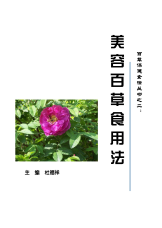
主要责任者: 杜福祥
责任方式: 主编
出版者: 中国学术期刊(光盘版)电子杂志社
出版地: 北京
页码: 1-214
语种:中
出版时间:2020-01
丛书多卷书否:否
书目简介:本册工具书共收录68条词条。
| 词条 | 美容百草食用法 |
| 类别 | 中文百科知识 |
| 释义 |  主要责任者: 杜福祥 责任方式: 主编 出版者: 中国学术期刊(光盘版)电子杂志社 出版地: 北京 页码: 1-214 语种:中 出版时间:2020-01 丛书多卷书否:否 书目简介:本册工具书共收录68条词条。 |
| 随便看 |
开放百科全书收录579518条英语、德语、日语等多语种百科知识,基本涵盖了大多数领域的百科知识,是一部内容自由、开放的电子版国际百科全书。